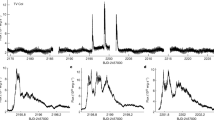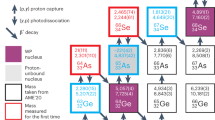Abstract
THE isotropy and flat count spectrum of γ-ray bursts revealed by the BATSE detector on the Compton Gamma-Ray Observatory1 have led to suggestions that the burst sources are an extended galactic halo of high-velocity neutron stars2,3We show here that if slow accretion onto these neutron stars from the interstellar medium is to be the origin of γ-ray bursts, the accretion physics is very different from what applies for local, low-velocity neutron stars4,5. For halo neutron stars with high magnetic fields and velocities (v > 190 km s–1), electromagnetic dipole radiation pressure prevents accretion unless the period is longer than tens of seconds; the centrifugal barrier will then prevent accretion until the period reaches several thousand seconds. For periods as long as this, accretion may proceed through Kelvin–Helmholtz instability at the magnetopause boundary. At interstellar densities and neutron-star magnetic fields of ∼1012 G, the accretion rate by this process can be much larger than the Bondi–Hoyle (hydrodynamic) accretion rate, but is still well below what is needed for slow-accretion burst models. We conclude that slow accretion onto high-velocity neutron stars in the halo cannot be the origin ofγ-ray bursts.
This is a preview of subscription content, access via your institution
Access options
Subscribe to this journal
Receive 51 print issues and online access
$199.00 per year
only $3.90 per issue
Buy this article
- Purchase on Springer Link
- Instant access to full article PDF
Prices may be subject to local taxes which are calculated during checkout
Similar content being viewed by others
References
Meegan, C. A. et al. Nature 355, 143 (1992).
Hartmann, D. Nature (submitted).
Dermer, C. D. & Li, H. in Proc. Huntsville Gamma-Ray Burst Workshop (eds Paciesas, W. S. & Fishman, G. J. (in the press).
Hameury, J. M., Bonazzola, S., Heyvaerts, J. & Ventura, J. Astr. Astrophys. 111, 242 (1982).
Blaes, O. R., Blandford, R. D., Madau, P. & Koonin, S. Astrophys. J. 363, 612–627 (1990).
Woosley, S. E. & Taam, R. E. Nature 263, 101 (1976).
Blaes, O. & Rajagopal, M. Astrophys. J. 381, 210–219 (1991).
Blaes, O., Blandford, R., Goldreich, P. & Madau, P. Astrophys. J. 343, 839 (1989).
Kluzniak, W. & Ruderman, M. in Proc. of Huntsville Gamma-Ray Burst Workshop (eds Paciesas, W. S. & Fishman, G. J. (in the press).
Blaes, O., Blandford, R., Madau, P. & Yang, L. Astrophys. J. (submitted).
Harrison, P. A., Lyne, A. G. & Anderson, B. in NATO ARW on X-ray Binaries and the Formation of Binary and Millisecond Pulsars (eds van den Heuvel, E. J. P. & Rappaport, S. J. (Kluwer, Dordrecht, in the press).
Narayan, R. & Ostriker, J. P. Astrophys. J. 352, 222 (1990).
Reynolds, R. J. in The Interstellar Disk-Halo Connection in Galaxies (ed. Bloemen, H.) 67–76 (Kluwer, Dordrecht, 1991).
Ruderman, M. A., Shaham, J. & Tavani, M. Astrophys. J. 336, 507 (1989).
Harding, A. K. & Gaisser, T. K. Astrophys. J. 358, 561–574 (1990).
Mineshige, S., Rees, M. J. & Fabian, A. C. Mon. Not. R. astr. Soc. 251, 555–563 (1991).
Illarionov, A. F. & Sunyaev, R. A. Astr. Astrophys. 39, 185–195 (1975).
Davies, R. E., Fabian, A. C. & Pringle, J. E. Mon. Not. R. astr. Soc. 186, 779–782 (1979).
Alcock, C. & Illarionov, A. Astrophys. J. 235, 541–553 (1980).
Burnard, D. J., Lea, S. M. & Arons, J. Astrophys. J. 266, 174–187 (1983).
Lasota, J. P. in Gamma-Ray Bursts (eds Ho, C. Epstein, R. I, & Fenimore, E. E.) 17 (Cambridge Univ. Press, 1992).
Murakami, T. et al. Nature 335, 234 (1988).
Silk, J. Phys. Rep. (in the press).
Author information
Authors and Affiliations
Rights and permissions
About this article
Cite this article
Harding, A., Leventhal, M. Can accretion onto isolated neutron stars produce γ-ray bursts?. Nature 357, 388–389 (1992). https://doi.org/10.1038/357388a0
Received:
Accepted:
Issue Date:
DOI: https://doi.org/10.1038/357388a0
This article is cited by
-
Towards a Unified View of Inhomogeneous Stellar Winds in Isolated Supergiant Stars and Supergiant High Mass X-Ray Binaries
Space Science Reviews (2017)
-
Gamma-ray bursts from nearby neutron stars
Astrophysics and Space Science (1993)
Comments
By submitting a comment you agree to abide by our Terms and Community Guidelines. If you find something abusive or that does not comply with our terms or guidelines please flag it as inappropriate.



